Wildlife and the Fenland Garden
Away from the smoke of the city. The countryside is ambient and calming.
I Love the Fenlands
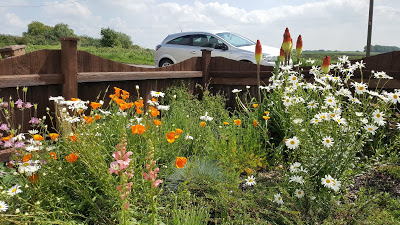
The Fenland
The entire area is tranquil. There are a few old market towns but most of the Fenland is like the video below. Much of this is what I see every day. Coming from a big city, I found it hard to adjust at first. Then it gradually grew on me. When I visit my old abode, I can't wait to get back to this tranquil solitude. The way of life is different. No one is in a rush. It looks bleak in the winter but the Fenland is far from this. Things happen all of the time.
The Fenland Garden
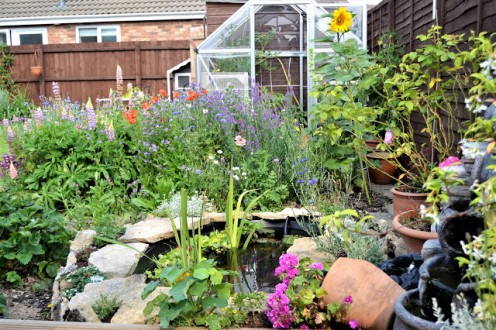
An Ambient Little Pond Feature for the Fenland Garden
One of the sad and annoying things about my job is fly-tipping. I live in a very rural and beautiful part of England. Yet still, we have the odd few who spoil the countryside. They drive out into the isolated areas and get rid of their rubbish in a small layby or wooded area. Sometimes I find the odd thing of use. However, the vast amount is garbage.
A short time ago, I found the mould of a small garden pond. It was dumped along with fly-tipping down a country lane. It was brand new. Never used. There were no punctures and I was at a loss as to why it was cast away. I brought it home and left it in the garden before returning to work. When I returned home after work, my wife Carole had dug a hole and placed the pond within. We had a lot of loose stone and rock which she had placed around the pond. Filled with enthusiasm, we went for a drive to the village of Murrow. There is an aquatic pond life centre there. Here we purchased a water pump and waterfall. We also bought some oxygenating plants.
We were like a couple of excited school kids. In no time at all, the filter pump and waterfall were working. The pond plants were put in. Our next trip was to a huge garden centre where we bought rockery alpine plants and peat. We even stopped and picked up bags of horse manure. Carole and I were on a roll. Our garden pond would be a delightful addition to the already developing garden. A couple of days later we acquired some pond fish. Six in all. In no time, we were sitting on the decking and listening to the ambient sound of the water feature and the waterfall. The alpine plants took to the task of enhancing our wonderful pond feature. It all looked and sounded relaxing.
Marsh Harrier
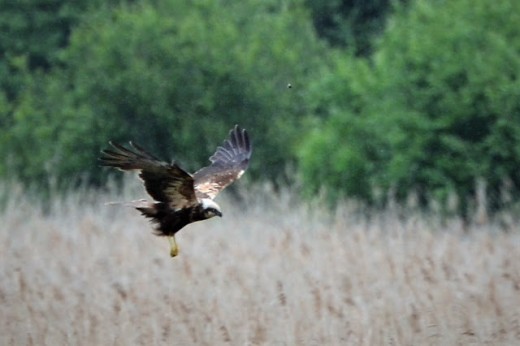
The bird hides of Manea
Everything is wonderful in the Fenland when it is summer. The winter has its appeal too. However, the fields are no longer full of vibrant crops. Everything is back to the ploughed and furrowed earth. The birds of prey are always easier to spot in the leafless trees. Especially the Common Buzzards as they stand sentinel over the bleak rutted fields. Often we go out down the country lanes towards a village called Manea. There are bird hides here. These scattered hides command a view across a Fen that floods and turns into a lake from November to March. The River Delph bursts its banks and the marshy meadows become a natural floodplain. In the distance, and often through marshland mist, we can see the spire of Ely Cathedral.
The appearance of the lake attracts all sorts of waterfowl. They are bobbing about in their hundreds. Various breeds. Carole, and I sit in the hides for a few hours looking at the many birds. I’m just interested in the birds of prey. The marshy fen is a favourite haunt for the many Marsh Harriers that come across the lake. The waterfowl always give us a warning when such graceful predators are gliding by. The game birds all start squawking and scattering. Their wings flapping in panic as they try to make way for the raptor. The spot that is vacated by the flustered multitude is always where the more fearsome bird’s flight path will be. I home in with the camera and hope for the best. Through the melee of confusion comes the unwelcome guest. Usually, the Harrier is too far off to get a good photo shot, but sometimes the odd one comes out fine. There are also other birds of prey to see. We have seen Hobbys, Buzzards, Red Kites, Kestrels and a Short Eared Owl. These raptors are always about the isolated bird hides. Carole and I go here regularly through the year.
During this summer, the lake vanishes and one can see the River Delph. The fields are occupied by grazing cattle again. The whole scene looks fresh and new. The trees are full of lush green leaves when they were bleak and bare a few months earlier. The whole land has come to life. The spring and summer bring swallows and swifts. There is a Kingfisher that comes along the River on the hunting patrol. There are rivers and Kingfishers everywhere. Also Reed Buntings and Reed Warblers.
The Hobby.
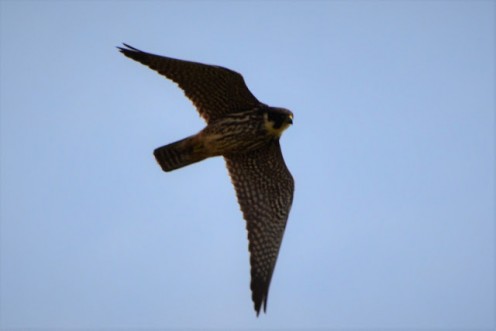
Fenland Birds of Prey
Common Buzzards, Red Kites, Marsh Harriers, Sparrow Hawks, Hobbys, Kestrels and many types of Owl. I have seen them all in the bird hides of the Fenland.
The Garden is full of Growing Wildlife.
Carole and I have some fabulous days. Not just at the hides but at our home by the open Fenland. Our bungalow looks out across the meadows. She loves the garden and is always tending the flowers and lawn. We have a grand decking area where we sit. Here, we enjoy the summer evenings when I return home from work. Over a period of time, we have put up bird boxes to try and entice Finches and Sparrows etc. The bird boxes have not been taken yet, though we did have a Jenny Wren look one over. Carole says a Jenny Wren male will make several nests. The female will then inspect the various choices of home and choose where to lay her eggs. Sadly our bird box was rejected by the female Jenny Wren. Perhaps next year she might look more favourably on the bird box.
However, in our ceonosis bush, Carole came upon a small nest. The bush is inside the coop where our ducks are kept. Carole was collecting the morning eggs lay. She saw a small Dunnock (hedge sparrow) leave the bush from the top and over the fence. She peeked into the ceonosis bush and found a nest with tiny blue eggs inside. Also, our magnolia tree had a pair of Goldfinches build a nest close to the top of the tree. I took some photos of the Dunnock eggs and then left the tiny birds to do their thing.
We had bird feeding tables put up and we watched the various small Finches, Sparrows, Robins and a Pied Wagtail. A blackbird was using the pond waterfall as a shower each morning and in the afternoon. The whole garden was a hive of activity. We enjoyed watching the creatures of habit. Carole and I were feeling exceptionally pleased with ourselves. In a short time, we noticed the Goldfinches coming backwards and forwards to their nest. Their eggs had hatched and the male and female were taking it in turns to bring food for the young. The three Dunnock eggs hatched too. I managed to get another photo shot of the young.
The Dunnock's Eggs and Nest.
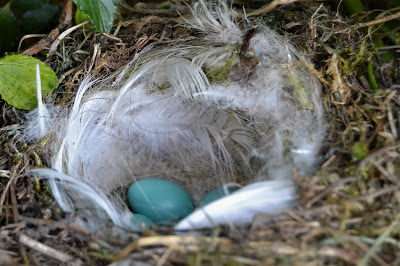
The Hatched Young of the Dunnock.
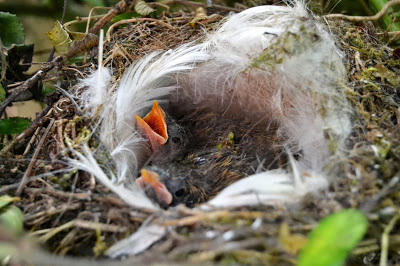
The Goldfinch Nest.
Then one morning as I was making a cup of tea, Carole came in from the garden. She was all flustered and said that the Goldfinches were jumping from the nest. One had fallen in front of our Ragdoll Cat, Bob. He is fat and very lazy and will not run after anything. But the helpless Goldfinch was right before him. Food from Heaven. He snatched it up, but Carole managed to get the poor thing from his jaws. I went into the garden and heard a fearful commotion from the top of the magnolia tree. The infant Goldfinches came fluttering down from the top of the nest. They were panicking because a group of sparrows were attacking them. They were just shy of fledging and in a terrible dilemma. Three of them landed on the lawn. I gathered the little creatures up and took them into Carole. The sparrows were still making a racket by the nest as I got my step ladders. As I placed them on the tree, the sparrows flew away. I climbed the ladder to the nest and saw the last baby Goldfinch. Sadly, it was blooded and dead.
The Goldfinch that our cat Bob had picked up died soon after. I think it was traumatised by the ordeal. The other three baby Goldfinches were also huddled and quite. Carole phoned the animal sanctuary and they gave us a number of a rescue centre close by. A lady answered and told us to try and keep them warm and in a dark place. We put them in a small hamster cage with some bedding and then in an airing cupboard. In a short time, a volunteer from the charity came up the drive. The lady was another helper from the rescue centre. She began to feed the chicks with a syringe and the little things responded well. One of them started hopping around the cage. The Volunteer seemed very confident that the birds would soon fledge. The woman took the Goldfinches away to nurse them through the final stages of their growing cycle to fledging successfully.
The Goldfinches were attacked by Sparrows.
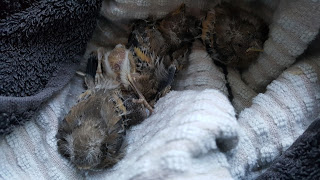
The Goldfinches Deserted Their Nest
Of the five Goldfinch chicks, only three survived. I would not have realised sparrows could be so destructive. The parent Goldfinches came back and were stressed that their young were gone. They would not know that three of their chicks had survived. Eventually, they abandoned the nest and flew off.
Dunnock (Hedge Sparrow)
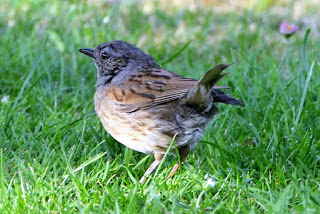
The Sparrow Hawk
Over the next few days, the Dunnock chicks left the nest and began to hop about the garden lawn. They always returned back to the Ceonosis bush where their nest was. One day when I was at work, I got a call on my mobile from Carole. She said she was sitting on the decking doing her Sudoku book. She was alerted by a commotion. A Sparrow Hawk had banged into the passionflower shrub growing up the side of the fence. The bird of prey’s high pitched screech filled the air. It was caught up in the vines, but got lose and flew off. It had one of the fledgeling Dunnocks in its talon. There were three of them. Now there were two. When I came home from work, Carole was telling me all about the Sparrow Hawk. We were sitting on the decking and the camera was on the table. Sometimes a Buzzard flew over and I was chancing for a photo shoot. Low and behold. As though on call. The very Sparrow Hawk, Carole spoke of, landed on the fence. It was looking for small birds that went to our bird table. I managed to take a few shots of the little raptor before it shot off. It was so quick. It dived low and then rose across our garden. Then swooped upwards and shot over the fence. Talons first it hit a huge bush in the garden next door. I don’t think it got anything, but it was an attempted strike at some small hedge bird. Carole or I could not see a catch as the Sparrow Hawk flew off.
This raptor passed by on a daily basis. Our garden was part of its hunting ground. The two remaining Dunnocks fledged and moved on. At least that is what we assumed. Also, the other smaller birds that visited the bird table seemed to continue. We never saw another Sparrow Hawk strike in the garden for the rest of the summer. It probably got results in other gardens.
Suddenly the Sparrow Hawk Appeared.
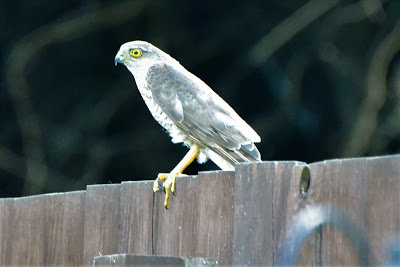



No comments:
Post a Comment